《放射治疗剂量学》课程教学资源(PPT专题讲稿)The Use of High-Energy Protons in Cancer Therapy

The Use of High-Energy Protons in Cancer Therapy 王鹏程印
The Use of High-Energy Protons in Cancer Therapy
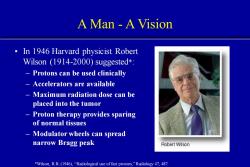
A Man A Vision In 1946 Harvard physicist Robert Wilson (1914-2000)suggested*: Protons can be used clinically Accelerators are available Maximum radiation dose can be placed into the tumor Proton therapy provides sparing of normal tissues Modulator wheels can spread narrow Bragg peak Robert Wilson *Wilson,R.R.(1946),"Radiological use of fast protons,"Radiology 47,487
A Man - A Vision • In 1946 Harvard physicist Robert Wilson (1914-2000) suggested*: – Protons can be used clinically – Accelerators are available – Maximum radiation dose can be placed into the tumor – Proton therapy provides sparing of normal tissues – Modulator wheels can spread narrow Bragg peak *Wilson, R.R. (1946), “Radiological use of fast protons,” Radiology 47, 487
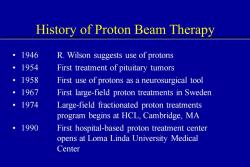
History of Proton Beam Therapy 1946 R.Wilson suggests use of protons 1954 First treatment of pituitary tumors 1958 First use of protons as a neurosurgical tool 1967 First large-field proton treatments in Sweden 1974 Large-field fractionated proton treatments program begins at HCL,Cambridge,MA 1990 First hospital-based proton treatment center opens at Loma Linda University Medical Center
History of Proton Beam Therapy • 1946 R. Wilson suggests use of protons • 1954 First treatment of pituitary tumors • 1958 First use of protons as a neurosurgical tool • 1967 First large-field proton treatments in Sweden • 1974 Large-field fractionated proton treatments program begins at HCL, Cambridge, MA • 1990 First hospital-based proton treatment center opens at Loma Linda University Medical Center
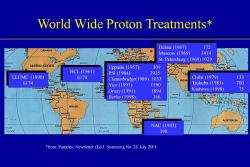
World Wide Proton Treatments* Dubna(1967) 172 CANADA GER POL Moscow (1969) 3414 St.Petersburg (1969)1029 NORTH UNITED STATES Uppsala(1957): 309 CHINA HCL(1961) PSI(1984) 3935 LLUMC (1990) 6174 Clatterbridge(1989):1033 Chiba (1979) 133 INDIA 6174 Nice(1991): 1590 Tsukuba (1983) 700 Orsay (1991): 1894 Kashiwa (1998) 75 Berlin(1998) 166 A N。6 BRAZIL AUSTRALIA NAC(1993) 0/72H SOUTH PACIFIC ATLANTIE 398 *from:Particles,Newsletter (Ed J.Sisterson),No.28.July 2001
World Wide Proton Treatments* LLUMC (1990) 6174 HCL (1961) 6174 Uppsala (1957): 309 PSI (1984): 3935 Clatterbridge(1989): 1033 Nice (1991): 1590 Orsay (1991): 1894 Berlin (1998): 166 Chiba (1979) 133 Tsukuba (1983) 700 Kashiwa (1998) 75 NAC (1993) 398 Dubna (1967) 172 Moscow (1969) 3414 St. Petersburg (1969) 1029 *from: Particles, Newsletter (Ed J. Sisterson), No. 28. July 2001
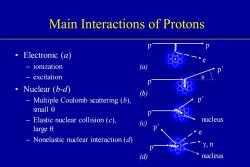
Main Interactions of Protons ·Electronic(a) ionization 一 excitation ·Nuclear(b-d Multiple Coulomb scattering (b). small 0 Elastic nuclear collision (c), nucleus large 0 Nonelastic nuclear interaction (d) Y,n d nucleus
Main Interactions of Protons • Electronic (a) – ionization – excitation • Nuclear (b-d) – Multiple Coulomb scattering (b), small q – Elastic nuclear collision (c), large q – Nonelastic nuclear interaction (d) e p p p’ p p p’ nucleus g, n p’ p e nucleus (b) (c) (d) (a) q
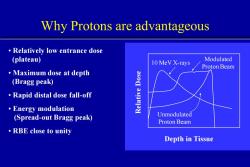
Why Protons are advantageous Relatively low entrance dose (plateau) 10 MeV X-rays Modulated Proton Beam ·Maximum dose at depth (Bragg peak) Rapid distal dose fall-off ·Energy modulation (Spread-out Bragg peak) Unmodulated Proton Beam ·RBE close to unity Depth in Tissue
Why Protons are advantageous • Relatively low entrance dose (plateau) • Maximum dose at depth (Bragg peak) • Rapid distal dose fall-off • Energy modulation (Spread-out Bragg peak) • RBE close to unity Depth in Tissue Relative Dose 10 MeV X-rays Modulated Proton Beam Unmodulated Proton Beam
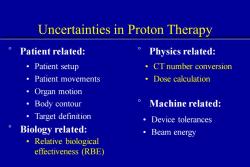
Uncertainties in Proton Therapy Patient related: Physics related: ·Patient setup ·CT number conversion ·Patient movements ·Dose calculation 。Organ motion ·Body contour Machine related: 。Target definition ·Device tolerances Biology related: ·Beam energy ·Relative biological effectiveness (RBE)
Uncertainties in Proton Therapy • Patient setup • Patient movements • Organ motion • Body contour • Target definition • Relative biological effectiveness (RBE) • Device tolerances ° Biology related: • Beam energy ° Patient related: ° Physics related: • CT number conversion • Dose calculation ° Machine related:
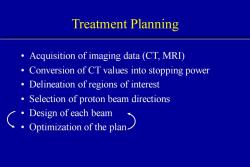
Treatment Planning Acquisition of imaging data(CT,MRI) Conversion of CT values into stopping power Delineation of regions of interest Selection of proton beam directions :cdmNe>
Treatment Planning • Acquisition of imaging data (CT, MRI) • Conversion of CT values into stopping power • Delineation of regions of interest • Selection of proton beam directions • Design of each beam • Optimization of the plan
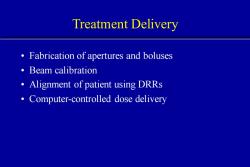
Treatment Delivery Fabrication of apertures and boluses ·Beam calibration Alignment of patient using DRRs Computer-controlled dose delivery
Treatment Delivery • Fabrication of apertures and boluses • Beam calibration • Alignment of patient using DRRs • Computer-controlled dose delivery
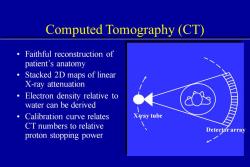
Computed Tomography (CT) Faithful reconstruction of patient's anatomy Stacked 2D maps of linear X-ray attenuation Electron density relative to water can be derived Calibration curve relates XAray tube CT numbers to relative Detector array proton stopping power
Computed Tomography (CT) X-ray tube Detector array • Faithful reconstruction of patient’s anatomy • Stacked 2D maps of linear X-ray attenuation • Electron density relative to water can be derived • Calibration curve relates CT numbers to relative proton stopping power
按次数下载不扣除下载券;
注册用户24小时内重复下载只扣除一次;
顺序:VIP每日次数-->可用次数-->下载券;
- 山东第一医科大学:《放射治疗剂量学》课程教学资源(PPT专题讲稿)放射治疗剂量学 Brife Introduction of Radiation Therapy and radiation dosimetry.ppt
- 山东第一医科大学:《放射治疗剂量学》课程教学资源(打印版)教学大纲(负责人:王鹏程).pdf
- 山东第一医科大学:《医学影像电子学》课程教学课件(打印版)第十章 逻辑代数及其化简.pdf
- 山东第一医科大学:《医学影像电子学》课程教学课件(打印版)第十四章 时序逻辑电路.pdf
- 山东第一医科大学:《医学影像电子学》课程教学课件(打印版)第十六章 AD、DA转换器.pdf
- 山东第一医科大学:《医学影像电子学》课程教学课件(打印版)第十五章 脉冲产生与整形电路.pdf
- 山东第一医科大学:《医学影像电子学》课程教学课件(打印版)第十二章 组合逻辑电路(Combinational Logic Circuit).pdf
- 山东第一医科大学:《医学影像电子学》课程教学课件(打印版)第十三章 触发器.pdf
- 山东第一医科大学:《医学影像电子学》课程教学课件(打印版)第十一章 门电路.pdf
- 山东第一医科大学:《医学影像电子学》课程教学课件(打印版)第六章 功率放大电路.pdf
- 山东第一医科大学:《医学影像电子学》课程教学课件(打印版)第八章 波形的产生与变换电路.pdf
- 山东第一医科大学:《医学影像电子学》课程教学课件(打印版)第五章 反馈放大电路.pdf
- 山东第一医科大学:《医学影像电子学》课程教学课件(打印版)第九章 直流稳压电源.pdf
- 山东第一医科大学:《医学影像电子学》课程教学课件(打印版)第七章 信号的运算与处理电路.pdf
- 山东第一医科大学:《医学影像电子学》课程教学课件(打印版)第四章 放大电路的频率响应.pdf
- 山东第一医科大学:《医学影像电子学》课程教学课件(打印版)第三章 集成运算放大器.pdf
- 山东第一医科大学:《医学影像电子学》课程教学课件(打印版)第二章 基本放大电路.pdf
- 山东第一医科大学:《医学影像电子学》课程教学课件(打印版)第一章 半导体器件基础.pdf
- 山东第一医科大学:《医学影像电子学》课程教学资源(打印版)医学影像电子学授课教案(负责人:郭永新).pdf
- 山东第一医科大学:《医学影像电子学》课程教学资源(打印版)医学影像电子学实验指导.pdf
- 《放射治疗剂量学》课程教学资源(PPT专题讲稿)Radiation Protection Refresher Course New Concepts in Radiation Shielding for Radiotherapy Facilities.ppt
- 《放射治疗剂量学》课程教学资源(PPT专题讲稿)RADIATION PROTECTION IN DIAGNOSTIC AND INTERVENTIONAL RADIOLOGY L 20 - Optimization of Protection in Digital Radiology.ppt
- 山东第一医科大学:《放射治疗剂量学》课程教学资源(PPT专题讲稿)医疗照射的辐射防护.ppt
- 《放射治疗剂量学》课程教学资源(PPT专题讲稿)头颈部放射治疗进展 Challenges in Optimal Delivery of Radiation in Head and Neck Cancers.ppt
- 《放射治疗剂量学》课程教学资源(PPT专题讲稿)医学物理工程的发展(北京大学:包尚联).ppt
- 《放射治疗剂量学》课程教学资源(PPT专题讲稿)21世纪CT技术革命 The Revolution of CT Technology(广州医学院:谢楠柱).ppt
- 《放射治疗剂量学》课程教学资源(PPT专题讲稿)关于发展我国医学物理学的思考(中国医学科学院:郑钧正).pdf
- 山东第一医科大学:《放射治疗剂量学》课程教学资源(打印版)放射治疗剂量学实验指导.pdf
- 广东医科大学:《临床生物化学及检验》课程教学资源(各章练习,含答案)第四章 酶学检测技术.pdf
- 广东医科大学:《临床生物化学及检验》课程教学资源(各章练习,含答案)第一章 绪论.pdf
- 广东医科大学:《临床生物化学及检验》课程教学资源(各章练习,含答案)第五章 自动生化分析技术.pdf
- 广东医科大学:《临床生物化学及检验》课程教学资源(各章练习,含答案)第六章 血浆蛋白质与含氮化合物的生物化学检验.pdf
- 广东医科大学:《临床生物化学及检验》课程教学资源(各章练习,含答案)第七章 糖代谢紊乱的生物化学检验.pdf
- 广东医科大学:《临床生物化学及检验》课程教学资源(各章练习,含答案)第八章 血浆脂代谢紊乱的生物化学检验.pdf
- 广东医科大学:《临床生物化学及检验》课程教学资源(各章练习,含答案)第九章 电解质与酸碱平衡的生物化学检验.pdf
- 广东医科大学:《临床生物化学及检验》课程教学资源(各章练习,含答案)第十章 微量元素与维生素异常的生物化学检验.pdf
- 广东医科大学:《临床生物化学及检验》课程教学资源(各章练习,含答案)第十一章 体液中酶的生物化学检验.pdf
- 广东医科大学:《临床生物化学及检验》课程教学资源(各章练习,含答案)第十二章 肝胆疾病的生物化学检验.pdf
- 广东医科大学:《临床生物化学及检验》课程教学资源(各章练习,含答案)第十三章 肾脏疾病的生物化学检验.pdf
- 广东医科大学:《临床生物化学及检验》课程教学资源(各章练习,含答案)第十四章 心血管系统疾病的生物化学检验.docx
